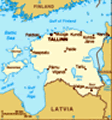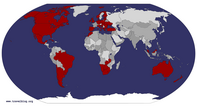Advertisement
Published: October 21st 2007
March 2005
The jewel of the Baltic is probably Estonia’s capital city, Tallinn - it’s got a combination of the sights, history and that general party spirit. Whilst it’s possible to start feeling this Old Town fatigue in this part of the Baltic, Tallinn’s is possibly the pick of the bunch. It might not be as big as the Vilnius version, but it has that dramatic visual impact not found elsewhere. The most striking feature is the defensive wall, a large part of which is still complete dating from the 1500s and is capped by 18 of the original towers with the red roofs that you’ll see in all the glossy brochures. You can see instantly why the cruise ships all pile into port in the summer months.
Estonia gives off that orderly feel from the moment you arrive at the airport - it almost has a more Scandinavian feel to it than the other Baltic capitals. The city centre is an easy 10 minute cab ride and then you can immerse yourself in history. We stayed at the Meriton Grand Hotel - just outside the old walls, but with a fabulous view of the Castle and only a
short stroll into the centre of proceedings. We were rubbing shoulders with the Slovakian FA delegation, who were in town for the 2006 World Cup qualifier on 25 March.
The direct route to the Old Town was via the Toompea Hill. Toompea's dominating landmark is the Alexander Nevsky Russian Orthodox Cathedral (named for the Duke who attacked south-eastern Estonia in the early 13th century). Tsar Alexander III ordered the cathedral designed in 1894 by St. Petersburg master Mikhail Preobrazhensky and it was completed in 1900, seemingly to let the locals know who was in charge of affairs at this point. Whilst the masters have changed, this is still the centre of Russian influence in Estonia and the majority of all the leaflets and booklets were printed in the Russian language. We found the Estonian language equally confusing mind, but never quite got to the bus station to order a beer form a ticket collector as per our Vilnius experience.
The Cathedral keeps a watchful eye on the building across the road, the pink section of which now houses the Riigikogu, Estonia’s parliament. This is effectively part of the Castle and on the corner you can see Pikk Hermann

 Kadriorg Palace
Kadriorg Palace
Peter the Great's holiday hometower with the blue, black and white Estonia’s tricolour flag waving above it. It’s commonly recognised that whoever’s flag flies on top of this tower is the ruler of Estonia. The national flag has been back in place since 1989 - the blue representing the sky, the black representing the soil and the white the aspirations of the Estonian people.
The nearby streets are extremely attractive to wander, although it’s a bit of a tourist trap in the nearby restaurants and bars and there are a large number of the obligatory of amber shops. The nearby Dome Church, also called St. Mary’s Church is supposed to be oldest church in Estonia. There are various viewpoints overlooking the city, which give you a good overview of both the old and the new and also out over the harbour where the ferries arrive from Helsinki.
The lower part of the Old Town is dominated by the Town Hall Square with it’s 13th century Hall in the centre. The weather when we were in Tallinn wasn’t exactly at boiling point, but this seemed to be the epicentre of pavement café society and outdoor drinking. There is a really good coffee shop
in the basement of the Town Hall, but drag yourself away to where the owners have their other business enterprise at the Chocolaterie Café on Vene 6 - here they serve a vast array of coffees and chocolate drinks with home-made chocolates in an old courtyard, that even has a small theatre attached. You can sit inside or they’ll even provide blankets if you are hardy enough to brave the snow outside! This was probably our favourite Baltic coffee break.
The rest of the Old Town is a maze of attractive streets and the only sinister presence was all the security outside what was the Russian Embassy - obviously not too popular these days! You’ll walk past it if you follow our drinking advice en route to the Hell Hunt - translated as Gentle Wolf - an Estonian micro brewery serving it’s own fayre and good priced food too! As they say in all the guide books, things change and prices go up - but highly recommended when we were around. See for yourself at hellhunt.ee There are also some interesting art nouveau buildings on this street, but most folk will head straight for the pub.
There are
plenty of more upmarket drinking venues in Tallinn, at least in the styling stakes - the prices proved to be fairly consistent anywhere in or near the Old Town. The Café Moskva was our other preferred venue, but if your looking for somewhere a bit different try the Stereo Lounge on Harju 6. Has a bar ever been so white since the arrival of the Pharmacy in Notting Hill? There are reviews that describe it as the Starship Enterprise, although the bar looks more like something from 1958!
The sporting diversion - well if you’ve read any of our other blogs you’ll know there would be one - was Slovakia’s comeback win in the 2006 World Cup qualifier. Estonia have moved on from their old post independence Kalev Stadium into a “new” stadium - the A Le Coq Arena. The arena is named after the major brewery in Estonia, in case you were wondering. The ground - it might be classified as a stadium, but not to the older readers - is just south of the city centre and did a very passable impression of a building site, despite having been opened in 2001. The game looked in doubt

 Dome Church
Dome Church
or St Mary's Cathedralon the morning, with the pitch covered in one of those hot air balloons that Leicester City specialised in before under-soil heating became part of everyday life.
The match wasn’t well attended with a crowd of only 3,000, although in fairness most Estonians were probably saving their Kroons for the Russia match on the following Wednesday. Estonia found themselves in the unusual position of leading 1-0 through a strike from starman, Andres Oper, before the Slovaks came back to sneak a win. Slovakia’s main man, The Lizard Nemeth, contributed very little - perhaps confused by actually starting a match, something he was not accustomed to at Awesome Park.
As it was an international week and it was sub zero, there was no chance of any local football. However in the interest of research, a foray was made to check out the Kalev Stadium and the Kadriorg Stadium, the home of Levadia Tallinn and TVMK and the scene of Scotland’s win against no opposition in 1996.
The district of Pirita proved an interesting diversion from the Old Town tourism. We walked for around an hour along by the beach and past the Soviet War Memorial to the area

 Ice Fishing
Ice Fishing
The Icebreaker himself - the alternative place to be drinking and thinkingwhere Tallinn hosted the yachting events for the 1980 Moscow Olympics. The authorities built the coastal Pirita highway, the TV Tower and the Olympic Yachting Centre for the occasion. There wasn’t a yacht in sight on the day we visited, but you could indulge in the altogether more unusual sport for us of walking on water - well ice actually, as the whole place was frozen solid. The locals were practising their ice fishing techniques - the smart ones keeping refuelled and warm with a copious supply of cans.
If you keep going just past the Yachting Centre, the Convent of St Birgitta makes some interesting photo backdrops away from the crowds and you can get the bus back into town from across the road.
The other part of Tallinn outside Old Town that is a must see is Kadriorg - literally Catherine’s Valley. It takes about 20 minutes to walk in the direction of Pirita, before you come across parkland and some posh villas. The main draw is the Kadriorg Palace - a magnificent, Baroque structure surrounded by manicured gardens and fountains. This was the centre of an estate that Russian Tsar, Peter the Great, established as
a family retreat in honour of his wife in the early 18th century.
The walk out in this direction from the city will highlight the high volume of ferry traffic coming in and out from Finland. We ventured down to the harbour out of interest - the scene was akin to that of Brits arriving in Calais to stock up on booze and fags. Finns complete with mobile trolleys seemed content to make enough purchases so as not to overload the said trolley and to decamp to the nearest bar to await a return ship. One of the closest favoured venues appeared to be the African Kitchen, where not only can you dine on spicy Nigerian dishes but you can see Finns (and other nationalities) happily smoking hubble bubble pipes.
In the interests of culture, we took in Coppelia at the Estonian National Theatre. If such performances interest you, tickets at £4 are a snip.
Advertisement
Tot: 0.191s; Tpl: 0.048s; cc: 13; qc: 31; dbt: 0.0527s; 1; m:domysql w:travelblog (10.17.0.13); sld: 1;
; mem: 1.1mb

























